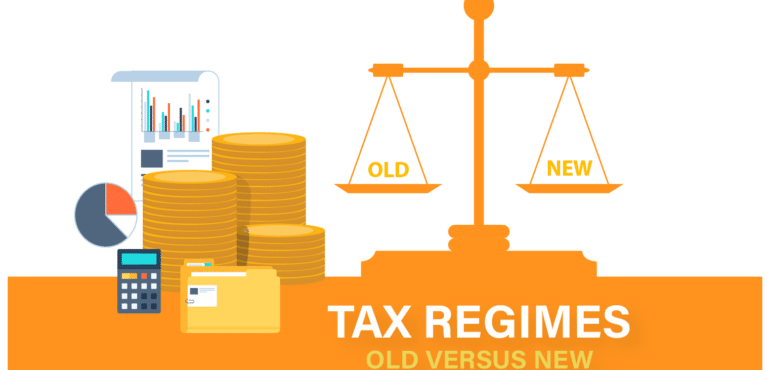The New Tax Regime VS the Old Tax Regime
In Budget 2020, our Finance minister surprised everyone by introducing a new tax regime under section 115BAC. This new tax regime has lower tax rates but took away exemptions and deductions available to taxpayers. With this new tax regime came the announcement that taxpayers can themselves choose between new or old tax regime.
So now taxpayers have to choose between the two regimes. Which regime to opt for?
Understanding the Old Tax Regime
The old tax regime has high tax rates but there are various ways to reduce the tax liability through exemptions and deductions. Exemptions are the parts of your income for which you don’t pay taxes. For e.g. LTA (Leave Travel Allowance), HRA(House Rent Allowance) and other deductions including savings, investments, spending on specific items like PPF, LIC, Mediclaim etc. through which assessees can claim deduction u/s 80C, 80CCC, 80CCD, 80D. These exemptions and deductions bring down the taxable income. In case of a self-occupied property, you cannot claim a deduction on interest for a housing loan under the new tax regime.
Understanding the New Tax Regime
Under the new tax regime, tax slab rates have increased up to Rs. 15 Lakh and all the exemptions and deductions which were being used by taxpayers in the existing regime wouldn’t be available in the new regime One can still claim deductions under sub-section (2) of section 80CCD which is basically an employer’s contribution towards employee’s account in NPS and section 80JJAA for new employment. In the case of a business income, an individual cannot claim set-off of the brought forward business loss or unabsorbed depreciation.
Choosing Between the Two Tax Regimes
- Both systems have their own sets of pros and cons. The old system has many exemptions and deductions under numerous sections – availing a few of these required people to invest in tax saving investment options, which helped inculcate a good habit of investing. On the other hand, the new system gives people more flexibility and tries to simplify the taxation process.
- A salaried taxpayer can opt-in and opt-out every year. However, once a non-salaried opts out of the new tax regime, they cannot opt-in again for the new tax regime in the future.
- If a taxpayer is confused about which tax regime will be beneficial, then they need to calculate the income tax liability under both regimes. And can choose the one where the tax liability is lower.
- In old tax regime, taxpayers have to find ways to optimise investments so as to keep the taxable income to the minimum, where as in new tax regime, it will simplify the process and tax payer can enjoy the tax at reduced rate.
Comparison between old and new tax rates
| Income Tax Slabs (Rs.) | Income Tax Rates (%)
Old Tax Regime |
Income Tax Rates (%)
New Tax Regime |
| Up to Rs.2.5 Lakh | Nil | Nil |
| Rs.2.5 – 5 Lakh | 5% | 5% |
| Rs.5 – 7.5 Lakh | 20% | 10% |
| Rs.7.5-10Lakh | 20% | 15% |
| Rs.10-12.5 Lakh | 30% | 20% |
| Rs.12.5 -15 Lakh | 30% | 25% |
| Above 15 Lakh | 30% | 30% |
The implication of both tax regimes:
Assuming the assessee is eligible for deduction under section 80C, 80D, standard deduction under section 16 and deduction for interest on housing loan under section 24(b):
| Income | Tax liability under New regime | Tax liability under Old regime | Net Tax saving |
| 2,50,000 | – | – | – |
| 3,00,000 | – | – | – |
| 4,00,000 | – | – | – |
| 5,00,000 | – | – | – |
| 6,00,000 | 23,400 | – | -23,400 |
| 7,00,000 | 33,800 | – | -33,800 |
| 8,00,000 | 46,800 | – | -46,800 |
| 9,00,000 | 62,400 | – | -62,400 |
| 10,00,000 | 78,000 | 28,600 | -49,400 |
| 11,00,000 | 98,800 | 49,400 | -49,400 |
| 12,00,000 | 1,19,600 | 70,200 | -49,400 |
| 13,00,000 | 1,43,000 | 91,000 | -52,000 |
| 14,00,000 | 1,69,000 | 1,11,800 | -57,200 |
| 15,00,000 | 1,95,000 | 1,40,400 | -54,600 |
| 16,00,000 | 2,26,200 | 1,71,600 | -54,600 |
| 17,00,000 | 2,57,400 | 2,02,800 | -54,600 |
| 18,00,000 | 2,88,600 | 2,34,000 | -54,600 |
| 19,00,000 | 3,19,800 | 2,65,200 | -54,600 |
| 20,00,000 | 3,51,000 | 2,96,400 | -54,600 |
If you need further assistance with taxation, you can reach out to us for assistance.
